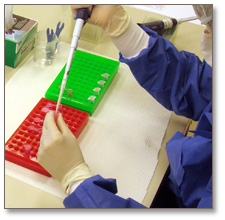Benefits of DNA Testing in the Diagnostic Testing Cycle
 Incorporating DNA testing into the diagnostic testing cycle for cancer confirms patient identity and sample purity significantly reducing the opportunity for adverse outcomes due to Specimen Provenance Complications (SPCs), switching and contamination errors.
Incorporating DNA testing into the diagnostic testing cycle for cancer confirms patient identity and sample purity significantly reducing the opportunity for adverse outcomes due to Specimen Provenance Complications (SPCs), switching and contamination errors.
Strand uses DNA Specimen Provenance Assay (DSPA) to match the DNA profiles of a patient’s self-identified cheek swab to the cancerous biopsy tissue to rule out the possibility of specimen contamination (i.e. confirm sample purity) and confirm the tissue belongs exclusively to the patient being evaluated.
While DNA testing is most commonly performed in forensic laboratories for the purpose of crime scene analysis and/or parentage, numerous researchers have acknowledged the potential benefits of leveraging this proven technology in the healthcare setting.
• A study published in The Journal of Urology suggested that the medical community may be ready for a “DNA Time-out” to address the problem of biopsy switching errors. Patient identification errors among prostate needle biopsies may be difficult to entirely prevent through the optimization of work flow processes. A DNA time-out, whereby DNA polymorphic microsatellite analysis is used to confirm patient identification before radiation therapy or radical surgery, may eliminate patient identification errors among needle biopsies.1
• Similar conclusions were drawn during a study that examined biopsy misidentification in a large multicenter trial. Published in the Journal of Clinical Oncology, authors stated, “The potential for biopsy mismatches in clinical trials and clinical practice is an under-recognized problem that requires rigorous attention to details of chain of custody and consideration of more widespread DNA identity testing.”2
• The American Journal of Clinical Pathology documented the rate of occult SPC occurrence and demonstrated the utility of DNA-based testing to detect the errors not captured by current laboratory protocols. This study3 found that up to 3.5% of biopsy specimens being evaluated may not belong exclusively to the patient being diagnosed, whether by specimen contamination or patient misidentification errors. By incorporating DNA Specimen Provenance Assay testing into the standard process for collecting and evaluating biopsies, patient safety can be improved through the identification of otherwise undetected specimen provenance errors that can lead to unnecessary medical interventions and/or delayed treatment.
• As published by The Journal of Urology the social and economic burden of healthcare expenditures associated with this SPC error rate data exceeded $8804 million annually and further concluded that 1 in 200 prostate biopsy patients are affected by specimen contamination or patient misidentification errors.
• Clinically significant admixtures5 (specimens with greater than 5% DNA contamination of another source) were recognized by the authors of a Washington University study as published in the American Journal of Clinical Pathology. The findings determined that 2% of the next-generation sequencing samples evaluated were so significantly contaminated by another’s DNA that the biomarker test results were confounded.
DNA Specimen Provenance Assay (DSPA), DNA testing, as part of the know error® system is increasingly becoming the standard of care to complete the diagnostic testing cycle for cancer, providing patients and physicians with a complete diagnosis to proceed with the personalized therapy for the appropriate patient.







